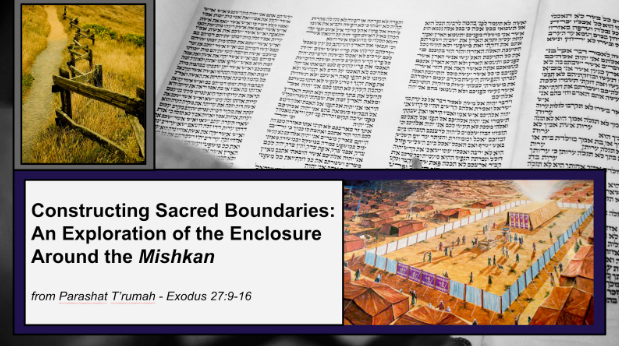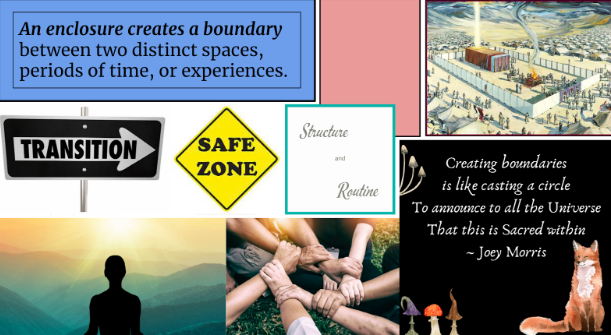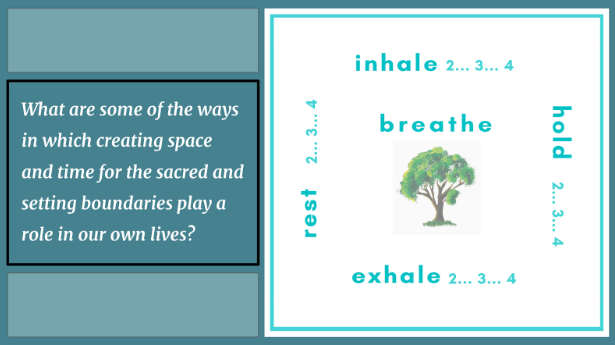The guest post below is the D’var Torah that CBI member and cantorial soloist Ziva Larson offered at Shabbat Morning Services on Saturday, February 25, 2023.
Constructing Sacred Boundaries:
An Exploration of the Enclosure Around the Mishkan
From Parashat T’rumah – Exodus 27:9-16
Let’s begin our exploration of Torah this week with a brief meditation. I invite you to find a comfortable seat, rest your hands in your lap or on your legs, and either close your eyes — if you feel comfortable — or let your gaze settle softly on a point somewhere in front of you. Now, let’s shift our attention to our breathing.
Start by noticing your breath without trying to change it. What does it feel like? Is it fast or slow? Is it easy or laborious? Where do you feel breath and movement in your body? Are there any areas of tension or softness? Does the air feel cool or warm as you inhale? What about as you exhale?
As we breathe together, I invite you to simply be and observe. If you wish, you may choose to focus on one or more of these questions as you breathe. If your mind wanders, that’s ok. Notice it, and then gently guide it back to the breath.
Now, let’s breathe together.
Inhale for a count of 1, 2, 3, 4. Pause 2, 3, 4. Exhale 2, 3, 4. Pause 2, 3, 4.
Inhale 2, 3, 4. Pause 2, 3, 4. Exhale 2, 3, 4. Pause 2, 3, 4.
Inhale 2, 3, 4. Pause 2, 3, 4. And release your breath with a big sigh.
Observe how your breath and body feel now. Are you aware of any shifts, or does everything feel the same as before? Either answer is totally fine. We are simply noticing what is.
Now, I invite you to gently blink your eyes open or refocus your gaze. And notice how we’ve used this brief meditation to delineate a place in time this morning for our exploration of Torah. This meditation is serving as an enclosure of sorts, creating a boundary around this special time.
In our Torah portion this week, Parashat T’rumah, we read about the instructions that God gave to Moses regarding the construction of an enclosure around the Tabernacle. The Tabernacle, also known as the Mishkan (מִּשְׁכָּן), is described in the Torah as an elaborate and costly but portable structure that the Israelites carried with them as they traveled in the desert. Its purpose was to be a dynamic, unfixed dwelling or space for the divine presence among them on Earth.
According to this week’s Torah portion, the Israelites had a very concrete understanding of what the Mishkan could be: a large, elaborate, portable tent. And in order to separate this holy space from the mundane spaces of everyday life, the Israelites constructed an enclosure around the Mishkan. The Torah goes into a lot of detail about the materials for the construction of the enclosure, which of course raises the question — why? Why is the construction of an enclosure around the Mishkan, around this dynamic, unfixed space for the divine presence, so important?
In general, an enclosure creates a boundary between two distinct spaces: the space within the enclosure, and the space outside the enclosure. We can expand our understanding of an enclosure to also include something that creates a boundary between two distinct periods of time or two distinct experiences. An enclosure enhances the significance of these spaces, times, and experiences. It separates the sacred from the mundane. It provides order and structure. It strengthens community by delineating a particular space or time for communal experiences. It aids in transitions by drawing our attention to the crossing from one space, time, or experience to another via a physical, visual, ritualistic, or other type of marker of the transition. It can provide protection and a sense of safety. And it can encourage a greater awareness — for example, of the world around us, of the divine, of everyday blessings — by helping us to focus our attention on the present moment.
As we read in the Torah this morning, the enclosure around the Mishkan — the Israelites’ Tent of Meeting — was a physical one made of posts and linen hangings. It was a concrete visual and physical boundary separating the sacred area of the Mishkan from the mundane space outside. However, if we expand our understanding of the Mishkan beyond the Israelites’ Tent of Meeting, the significance of having an enclosure around the Mishkan grows and becomes more apparent.
In our contemporary understanding, a Mishkan is a space (or even a time or an experience) that promotes access to the divine, communication about or with the divine, and connection with the divine. It is a space that might, through these qualities, offer opportunities for connection, hope, healing, repair, comfort, protection, learning, growth, justice, and transformation. And, like the Israelites’ Tent of Meeting, our contemporary Mishkan is dynamic and unfixed. It is not tied to a specific location, structure, time, or type of experience.
For example, a contemporary Mishkan could still be a physical space, such as a synagogue or outside in nature. Alternatively, it could be a spiritual experience created through the use of things like prayer, meditation, music, and ritual. Additionally, according to Jewish philosopher Martin Buber’s I-Thou philosophy, God — or the divine — is present in the relationship between two beings. Therefore, we can create a place for the divine presence — a Mishkan — by being in relationship with others. We can also create a Mishkan — a place where we can experience the divine presence — inside ourselves in our hearts and minds. And if we look externally, we can create a Mishkan through the actions we take in the pursuit of tikkun olam — working to make the world a better place by pursuing connection, hope, healing, repair, comfort, protection, learning, growth, justice, and transformation — essentially building a Mishkan in our communities and in our world.
Now that we have a broader understanding of what a Mishkan can be, let’s explore examples of enclosures or boundaries around a contemporary Mishkan. Of course there is the obvious: using physical walls or fences to enclose a sacred or special space. Another possibility is using rituals to put a boundary around a particular time, such as lighting and blessing candles as we enter the sacred time of Shabbat. Additionally, scheduling a specific time to connect with a person or community or to engage in an activity or cause can create a boundary around those experiences. Even engaging in a sensory experience such as wrapping a blanket around ourselves can create an enclosure for our physical and emotional selves. It provides a sense of safety and comfort, creates a time for unplugging, restoring, recentering, reflecting, and reconnecting with ourselves, and perhaps helps us to focus on and identify sensations and experiences that aid us in feeling more grounded and present. And in general, pausing to notice our internal and external experiences and practicing mindfulness can promote a separation between the constant, mindless, rushing flow of our days and a moment in time when we can reconnect with ourselves, others, our environment, and the divine.
So how do we create a Mishkan — a space or time for the sacred — in our lives? As we learned from our Torah portion today, one way we can do this is by creating enclosures — by setting boundaries — around the spaces, times, and experiences that offer opportunities for connection, hope, healing, repair, comfort, protection, learning, growth, justice, and transformation. As we enter into a new week, I invite you to consider some of the ways in which creating space and time for the sacred and setting boundaries play a role in our own lives.
And as we come to the end of our exploration of Torah today, we’ll conclude with the same meditation that we did at the beginning, creating a boundary or enclosure around our journey into Torah.
I invite you to find a comfortable seat, rest your hands in your lap or on your legs, and either close your eyes — if you feel comfortable — or let your gaze settle softly on a point somewhere in front of you.
Now, let’s breathe together.
Inhale for a count of 1, 2, 3, 4. Pause 2, 3, 4. Exhale 2, 3, 4. Pause 2, 3, 4.
Inhale 2, 3, 4. Pause 2, 3, 4. Exhale 2, 3, 4. Pause 2, 3, 4.
Inhale 2, 3, 4. Pause 2, 3, 4. And release your breath with a big sigh.
May you be blessed with boundaries and enclosures in your life that help you to experience connection, hope, healing, repair, comfort, protection, learning, growth, justice, and transformation.
Shabbat shalom.










